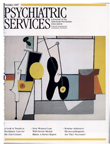Relevance of routine admission electrocardiograms for psychiatric patients
Abstract
OBJECTIVE: To make clinically relevant recommendations for electrocardiogram (ECG) testing among psychiatric patients, the study examined the practice of ordering ECGs for this population. METHODS: The records of 4,045 patients consecutively admitted for psychiatric care to seven community teaching hospitals over one year were examined. The frequency of ECG orders was documented, and abnormal ECG results were grouped into two categories: relevant to psychiatric treatment (ischemia or conduction defects) and incidental to treatment (minor abnormalities and screening abnormalities). For those with abnormalities, additional cardiac follow-up data were recorded. Associations between ECG results and patients' characteristics were analyzed. RESULTS: ECGs were performed for 2,857 (71 percent) of first admissions, of which 2,225 (78 percent) showed neither relevant nor screening abnormalities. Eighteen percent of those tested had relevant abnormalities, most commonly a first-degree atrioventricular block or some evidence of a myocardial infarction. ECG screening abnormalities were found for another 4 percent, primarily left ventricular hypertrophy (3 percent), but no follow-up occurred for 46 percent of these patients. Among patients under 40 years of age, 8 percent had relevant abnormalities, and 3 percent had screening abnormalities. Among patients without apparent cardiac risk, 10 percent had relevant and 3 percent had screening abnormalities. More than half the patients who had a second or third admission during the year had a repeat ECG, even when previous ECGs were normal. CONCLUSIONS: Routine ECG is not an effective treatment or screening tool in this population, and substantial cost savings could result from more selective testing, particularly among young patients, those at low risk, and those with repeat admissions.



